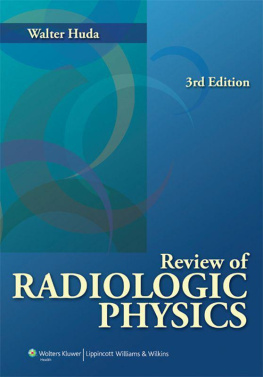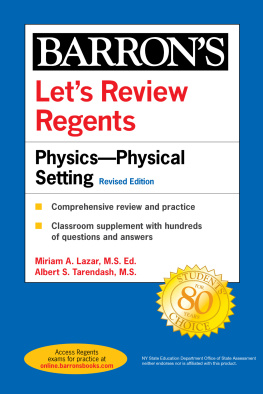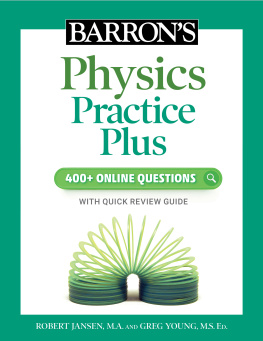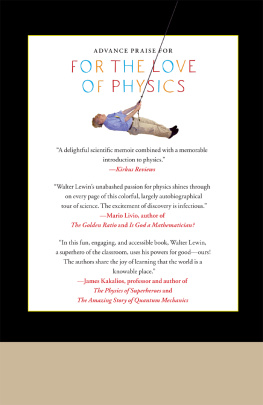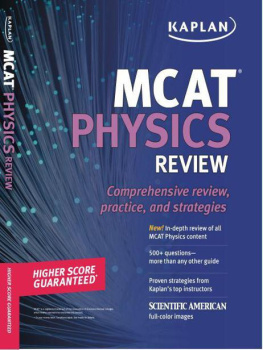Walter Huda - Review of Radiologic Physics
Here you can read online Walter Huda - Review of Radiologic Physics full text of the book (entire story) in english for free. Download pdf and epub, get meaning, cover and reviews about this ebook. year: 2012, publisher: Lippincott Williams & Wilkins, genre: Romance novel. Description of the work, (preface) as well as reviews are available. Best literature library LitArk.com created for fans of good reading and offers a wide selection of genres:
Romance novel
Science fiction
Adventure
Detective
Science
History
Home and family
Prose
Art
Politics
Computer
Non-fiction
Religion
Business
Children
Humor
Choose a favorite category and find really read worthwhile books. Enjoy immersion in the world of imagination, feel the emotions of the characters or learn something new for yourself, make an fascinating discovery.
- Book:Review of Radiologic Physics
- Author:
- Publisher:Lippincott Williams & Wilkins
- Genre:
- Year:2012
- Rating:4 / 5
- Favourites:Add to favourites
- Your mark:
- 80
- 1
- 2
- 3
- 4
- 5
Review of Radiologic Physics: summary, description and annotation
We offer to read an annotation, description, summary or preface (depends on what the author of the book "Review of Radiologic Physics" wrote himself). If you haven't found the necessary information about the book — write in the comments, we will try to find it.
Review of Radiologic Physics — read online for free the complete book (whole text) full work
Below is the text of the book, divided by pages. System saving the place of the last page read, allows you to conveniently read the book "Review of Radiologic Physics" online for free, without having to search again every time where you left off. Put a bookmark, and you can go to the page where you finished reading at any time.
Font size:
Interval:
Bookmark:
 Acquisitions Editor: Brian Brown Managing Editor: Ryan Shaw Marketing Manager: Angela Panetta Production Editor: Beth Martz Creative Director: Doug Smock Compositor: Aptara, Inc. Third Edition Copyright 2010, 2003 Lippincott Williams & Wilkins, a Wolters Kluwer business.
Acquisitions Editor: Brian Brown Managing Editor: Ryan Shaw Marketing Manager: Angela Panetta Production Editor: Beth Martz Creative Director: Doug Smock Compositor: Aptara, Inc. Third Edition Copyright 2010, 2003 Lippincott Williams & Wilkins, a Wolters Kluwer business.
| 351 West Camden Street | 530 Walnut Street |
| Baltimore, MD 21201 | Philadelphia, PA 19106 |
To request permission, please contact Lippincott Williams & Wilkins at 530 Walnut Street, Philadelphia, PA 19106, via email at permissions@lww.com , or via website at lww.com (products and services). 9 8 7 6 5 4 3 2 1 Library of Congress Cataloging-in-Publication Data Huda, Walter. Review of radiologic physics / Walter Huda.3rd ed. p. ; cm. Includes bibliographical references and index.
E-ISBN: 978-1-4511-2205-3 1. Radiology, MedicalOutlines, syllabi, etc. 2. Medical physicsOutlines, syllabi, etc. I. [DNLM: 1. [DNLM: 1.
Health PhysicsExamination Questions. WN 18.2 H883r 2010] R896.5.H83 2010 616.0754076dc22 2009008871 DISCLAIMER Care has been taken to confirm the accuracy of the information present and to describe generally accepted practices. However, the authors, editors, and publisher are not responsible for errors or omissions or for any consequences from application of the information in this book and make no warranty, expressed or implied, with respect to the currency, completeness, or accuracy of the contents of the publication. Application of this information in a particular situation remains the professional responsibility of the practitioner; the clinical treatments described and recommended may not be considered absolute and universal recommendations. The authors, editors, and publisher have exerted every effort to ensure that drug selection and dosage set forth in this text are in accordance with the current recommendations and practice at the time of publication. However, in view of ongoing research, changes in government regulations, and the constant flow of information relating to drug therapy and drug reactions, the reader is urged to check the package insert for each drug for any change in indications and dosage and for added warnings and precautions.
This is particularly important when the recommended agent is a new or infrequently employed drug. Some drugs and medical devices presented in this publication have Food and Drug Administration (FDA) clearance for limited use in restricted research settings. It is the responsibility of the health care provider to ascertain the FDA status of each drug or device planned for use in their clinical practice. To purchase additional copies of this book, call our customer service department at (800) 638-3030 or fax orders to (301) 223-2320. International customers should call (301) 223-2300. Visit Lippincott Williams & Wilkins on the Internet: http://www.lww.com. Lippincott Williams & Wilkins customer service representatives are available from 8:30 am to 6:00 pm, EST. To my parents,
Stefan and Paraskevia Huda,
for their resolute support and encouragementOrdinary language is totally unsuited for expressing what physics really asserts, since the words of everyday life are not sufficiently abstract.
Only mathematics and mathematical logic can say as little as the physicist means to say. B ERTRAND R USSELL  Contents
Contents Six years have now passed since the second edition of Review of Radiologic Physics appeared. The focus of this book remains imaging using x-rays (i.e., projection radiography, fluoroscopy, and CT), as well as nuclear medicine, ultrasound, and magnetic resonance (MR). Only essential information is included to help radiology residents and radiologic technologists understand how images are created, as well as the corresponding risks of the radiation used to make these images. Basic physics topics relating to the production and interaction of x-rays have been kept to a minimum, while more important topics of radiation biology, radiation protection, and nuclear medicine have been expanded. In this third edition, major changes have been made with respect to the organization as well as content of the text, tables, figures, and questions. The first two chapters deal with x-ray production and x-ray interactions.
Six years have now passed since the second edition of Review of Radiologic Physics appeared. The focus of this book remains imaging using x-rays (i.e., projection radiography, fluoroscopy, and CT), as well as nuclear medicine, ultrasound, and magnetic resonance (MR). Only essential information is included to help radiology residents and radiologic technologists understand how images are created, as well as the corresponding risks of the radiation used to make these images. Basic physics topics relating to the production and interaction of x-rays have been kept to a minimum, while more important topics of radiation biology, radiation protection, and nuclear medicine have been expanded. In this third edition, major changes have been made with respect to the organization as well as content of the text, tables, figures, and questions. The first two chapters deal with x-ray production and x-ray interactions.
Three chapters address how x-rays can be used to generate projection and tomographic images. Image quality (i.e., contrast, resolution, and noise) is now comprehensively covered in one chapter, which describes both the basic concepts and the specific values of these parameters for all imaging modalities that use x-rays. Radiation biology and radiation protection are both very important topics that now merit their own chapters. Material on nuclear medicine, ultrasound, and MR has been updated, but these chapters continue to focus on basic physics. Accordingly, only minimal information is provided on the more advanced applications of nuclear medicine, ultrasound, and MR that are currently used in clinical practice. One important theme in the revised books is to focus on the material that non-physicists need to understand to permit them to perform routine clinical duties.
Selection of material has been guided by whether the material is necessary to really understand three issues: (a) the essentials (but not details) as to how any image is created; (b) the factors that impact on the image quality, and how this feature can be controlled and optimized; (c) the factors that impact on (any) imaging risks and other imaging costs, and how these characteristics can be minimized without adversely affecting diagnostic information. Another important goal has been to simplify the material by minimizing superfluous details as well as streamlining all tables and simplifying the figures to convey only the most important features. The author firmly believes that the provision of an approximate conceptual mental picture of image formation is much more valuable than detailed descriptions that may be technically accurate but are of minimal didactic value. Most of the questions in the book have now been revised and, hopefully, improved. Each question relates to a specific piece of information that the author believes to be important for residents and technologists to know. In writing these questions, every effort has been made to ensure that they are clear and unambiguous; as such, the author would expect that any physics teacher would grasp why a particular question was being asked, as well as being able to immediately identify the correct answer.
The two practice tests contain 10 questions from each chapter, and are designed to permit residents to assess how well they have assimilated the material presented in this review. As with previous editions, readers need to understand that this review book does not explain any topic in full detail. Accordingly, the material covered in this book should be read in conjunction with a more comprehensive textbook on the topic of medical imaging. 
Font size:
Interval:
Bookmark:
Similar books «Review of Radiologic Physics»
Look at similar books to Review of Radiologic Physics. We have selected literature similar in name and meaning in the hope of providing readers with more options to find new, interesting, not yet read works.
Discussion, reviews of the book Review of Radiologic Physics and just readers' own opinions. Leave your comments, write what you think about the work, its meaning or the main characters. Specify what exactly you liked and what you didn't like, and why you think so.

